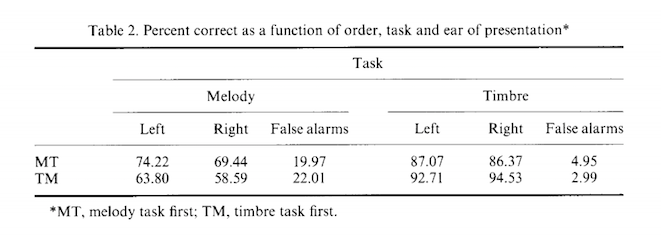
Title of paper under discussion
Laterality effects in the processing of melody and timbre
Authors
RUSS BOUCHER and M. P. BRYDEN
Journal
Neuropsychologia, Vol. 35, No. 11, pp. 1467-1473. 1997
Link to paper (free access)

Overview
Listening with headphones to a series of musical excerpts – each of which was in fact two different melodies playing at once, one in each ear – participants in this experiment were asked after each excerpt whether or not they had spotted a ‘target’ in either ear. In the first set of excerpts (‘melody task’) this target was a specific melody, for example ‘Non più andrai’ from Mozart’s ‘Marriage of Figaro’; meaning that in some of the excerpts ‘Non più andrai’ was the melody being played to one of the ears. For the second set of excerpts (‘timbre task’) the target to listen out for was a specific instrument playing one of the melodies – for example clarinet.
Female participants were better at spotting melodies played to their left ears than to their right, whereas male participants showed no such melody ‘ear advantage’. Neither sex showed an ‘ear advantage’ in spotting instrumental timbre.
This ‘left ear advantage’, more pronounced in women than men, for processing melody complements a recognised ‘right ear advantage’, more pronounced in men than women, for processing words.

Method
Audio tracks of four different melodies (taken from the duettino Là ci darem from W. A. Mozart’s Don Giovanni, K. 527; the aria Non più andrai from W. A. Mozart’s Le Nozze di Figaro, K. 492; and the March in D major from J. S. Bach’s Notebook of Anna Magdalena Bach, BWV 508-18) were created, each one in four different synthetic versions: for clarinet, harp, piano and trumpet. With each melody recorded in each timbre, the researchers boasted a total of 16 tracks for use in the experiment.
32 men and 32 women, all right-handed non-musicians, were recruited from the University of Waterloo, Ontario. None had ever taken instrumental music lessons. To begin each experiment, the individual participant was asked to learn to recognise a ‘target’. For the ‘melody task’ this meant listening to, and so learning to recognise, a target melody (one chosen by the researchers from the four melodies); and for the ‘timbre task’ it meant listening to, and so learning to recognise, a target timbre (one chosen by the researchers from the four timbres). Each participant was assigned to listen out for just one such target melody (in the melody task), and one such target timbre (in the timbre task). So, for example, a particular participant might have been listening out for ‘Là ci darem’ in the melody task, and then any melody played on the ‘trumpet’ in the timbre task.

Once trained to recognise their targets, the participant underwent a series of trials. In each trial, two different melodies were presented simultaneously to the participant through binaural headphones, with the melody to the right ear always different to that to the left; all 144 possible paired combinations of the 16 tracks were used in each experiment.
In the melody task trials, the participant was asked to circle a “yes” on a response sheet every time she or he recognised their target melody being played in either ear. Similarly, in the timbre task trials, every recognition of the target timbre was recorded.
Aside from the trials, participants were also asked how much they listened to music in their everyday lives.

Results
Each participant’s ‘ear advantage’ – a metric determining whether melodies, or timbres, were more likely to be spotted if presented in the right ear (‘right ear advantage’) or in the left ear (‘left ear advantage’) – was determined using a formula that balanced the number of correct “Yes” responses against the number of melodies/timbres that were not spotted.
Women were more likely to show a ‘left ear advantage’ for melody recognition, whereas men showed no ‘ear advantage’ for melody but tended to be more accurate at recognising melodies overall. Neither men nor women exhibited an ‘ear advantage’ when it came recognising timbre. This table shows the percentage of correct responses, in the melody and timbre tasks, according to sex and ‘ear of presentation’:

Participants performed more accurately (in both ears) in whichever experiment – melody task or timbre task – came first out of the two:

Participants who spent more time listening to music in their everyday lives were more accurate on the melody task, but not on the timbre task. And these ‘more musically familiar’ participants didn’t exhibit higher levels of ‘ear advantage’, left or right, with either task.
Finally, the overall accuracy of a given individual participant’s responses did not predict their levels of ‘ear advantage’; nor did an individual’s level of melody ‘ear advantage’ correlate with their level of timbre ‘ear advantage’.
Discussion

Auditory sensations in the right ear are mainly, but not exclusively, processed by the left hemisphere of the brain, and those in the left ear by the right hemisphere. Hence the authors’ assertion that the “overall emergence of an LEA [left ear advantage] for melody recognition supports previous research suggesting that the right hemisphere is superior for the processing of musical stimuli”.
Boucher and Bryden has predicted that timbre, which is heavily dependent on the subtle timings of ‘attack’ frequencies, might be better perceived by the right ear, because previous research had suggested that the left hemisphere of the brain is ‘dominant’ for such temporal (timing) processing. However, such ‘right ear advantage’ was not clearly evident in their results for the timbre task, even though the results perhaps hinted at it; this may, they suggest, be because the task was too easy, and that repeating the experiment using timbres more difficult to differentiate might in future reveal the ‘right ear advantage’ they were expecting.
The suggestion from these results that “laterality [left or right ear advantage] for melody recognition is independent of laterality for timbre recognition” pleased Bryden; he had previously argued that just because in general people exhibit a ‘right ear advantage’ for verbal processing and a ‘left ear advantage’ for non-verbal processing, it doesn’t mean those two lateralities are themselves related. Results from this paper, he argues, support his idea that “the observation in an individual that one hemisphere is specialized for a particular function implies nothing about the functions of the other hemisphere in that individual”.
In conclusion, the authors once more stress the way in which the findings of this study – that women appear to have a greater ‘left ear advantage’ of melody recognition than men – complements previous studies (with similar methods) of verbal listening in which men tended to show a greater ‘right ear advantage’ than women. In the words of Boucher “This supports the idea of a complementary sex-based pattern of auditory lateralization, with males more strongly lateralized for verbal stimuli and females more strongly lateralized for non-verbal stimuli”.

Coda
Non più andrai from W. A. Mozart’s Le Nozze di Figaro, K. 492
Figaro – Bryn Terfel
BBC Welsh Symphony Orchestra, cond. Kees Bakels